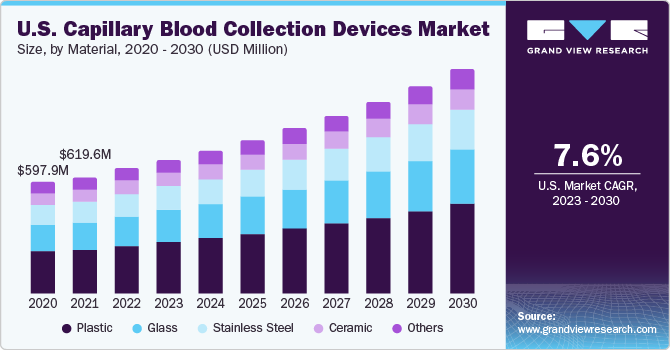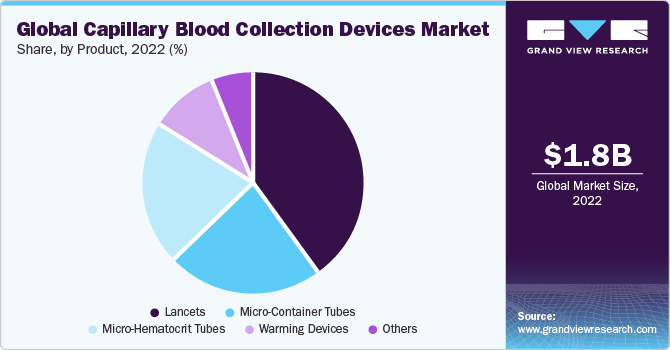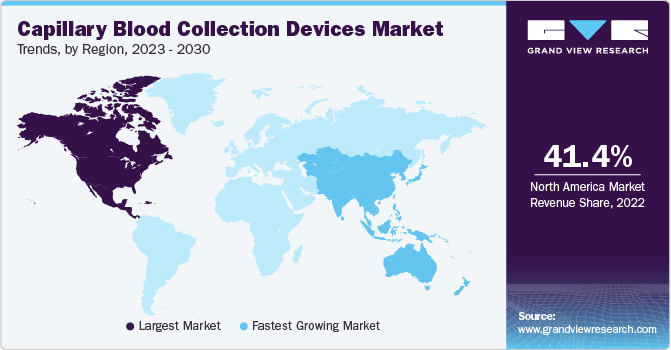- Home
- »
- Medical Devices
- »
-
Capillary Blood Collection Devices Market Size Report, 2030GVR Report cover
![Capillary Blood Collection Devices Market Size, Share & Trends Report]()
Capillary Blood Collection Devices Market Size, Share & Trends Analysis Report By Material (Plastic, Glass, Stainless Steel, Ceramic, Others), By Product, By End-use, By Application, By Region, And Segment Forecasts, 2023 - 2030
- Report ID: GVR-2-68038-998-2
- Number of Report Pages: 125
- Format: PDF, Horizon Databook
- Historical Range: 2018 - 2021
- Forecast Period: 2023 - 2030
- Industry: Healthcare
Market Size & Trends
The global capillary blood collection devices market size was valued at USD 1.82 billion in 2022 and is expected to grow at a compound annual growth rate (CAGR) of 8.9% from 2023 to 2030. Rising availability of PoC diagnostics, increasing prevalence of chronic diseases such as diabetes, cardiovascular diseases, and infectious diseases, and various advantages of the product, including frequent blood testing and monitoring, over its alternatives are some of the primary factors driving the market. In addition, the higher prevalence of anemia in developing countries is also driving the demand for capillary blood collection devices as they offer a convenient and accessible blood sampling method. As per World Health Organization estimates, 40% of children aged 6-59 months, 37% of pregnant women, and 30% of women aged 15-49 years globally are suffering from anemia.

There has been a tremendous rise in the number of infectious and non-communicable diseases in the past few decades. Rapid urbanization, borderline poverty in most developing regions, antimicrobial resistance, and rising prevalence of foodborne diseases are some factors causing their increased prevalence. These factors are anticipated to stimulate market growth during the forecast period. The WHO estimates that non-communicable diseases such as chronic respiratory disorders, cardiovascular disorders, cancer, and diabetes contributed to 74% of the total deaths in 2022 worldwide.
The area of PoC diagnostics has witnessed tremendous growth in the recent past, owing to the introduction of technologies such as bioanalytical platforms, biosensors, novel assay formats, and other complementary research techniques. According to Population Reference Bureau data in the U.S., the population in the country aged 65 and older is estimated to almost double from 52 million in 2018 to 95 million by 2060, which is likely to increase the demand for PoC diagnostics.
Development of novel molecular diagnostics has facilitated rapid diagnosis at lower costs and at greater convenience. Capillary blood collection devices facilitate rapid hematology tests with the aid of PoC diagnostics. In comparison to venous and arterial blood collection, this form of sample collection is less invasive, inexpensive, and does not require a trained professional for the blood draw procedure.
Increasing adoption of rapid PoC diagnostics and the usage of capillary blood collection devices is expected to rise over the forecast period. Capillary blood draw technique in conjugation with PoC diagnostics has become the chosen mode of testing in remote and ambulatory health settings. Capillary blood drawing technique has been most widely used for hemoglobin and glucose testing in clinics and hospitals. Ease of use and its minimally invasive nature also make it ideal for home care diagnosis and testing, thereby boosting market growth.
The COVID-19 pandemic had a significant impact on the capillary blood collection device market. The demand for these devices surged in this period due to the widespread need for testing and monitoring of COVID-19 cases. Capillary blood collection devices played a crucial role in rapid antigen tests, antibody testing, and other diagnostic procedures, allowing for easy and convenient sample collection. The pandemic highlighted the importance of efficient and accessible testing methods, leading to increased adoption of capillary blood collection devices.
However, the market also faced challenges due to the disruptions caused by the pandemic. Supply chain disruptions, including raw material shortages and transportation delays, impacted the production and distribution of capillary blood collection devices. The increased demand and limited availability of these devices created a supply-demand gap, leading to temporary shortages in some regions.
The pandemic impact on healthcare systems and priorities also influenced the market for capillary blood collection devices. As healthcare resources were diverted to COVID-19 response, routine diagnostic procedures and non-essential medical visits were postponed or reduced, affecting the demand for capillary blood collection devices for non-COVID-19 testing purposes. Despite these challenges, the long-term outlook for the capillary blood collection devices industry remains positive.
Material Insights
The plastic segment accounted for the largest revenue share of 38.6% in 2022. This is due to its high adoption, ease of usage & disposal, and cost-effective nature. Plastic devices are commonly used in various collection products as they are lightweight and biocompatible with the human body. In the past few decades, plastic is increasingly being used for manufacturing medical devices. Safety, chemical stability, clarity, flexibility, and durability are some major factors contributing to its increasing adoption in healthcare settings. The segment is expected to maintain its dominance through the forecast period.
In comparison to plastic, glass products can be easily recycled, thereby improving environmental sustainability. Thus, an increasing number of manufacturers are engaged in the production of glass-based products and devices. Glass also has a high resistance to heat and thus, is preferred over other raw materials for the manufacturing of medical devices. Stability, accuracy, and resistance to antimicrobial growth are some of the major reasons for the high adoption of this material.
Ceramic is used in the manufacturing of capillaries, connectors, adapters, and other related accessories. Some of the merits of the material include its lightweight nature, its high resistance to heat and temperature, and its superior electrical insulation. The mechanical strength of these materials is one of the key factors responsible for their usage in the medical field. Its expensive nature and high cost of manufacturing are, however, limiting the growth of the ceramic segment during the forecast period.
End-use Insights
Based on end-use, the hospitals and clinics segment accounted for the largest revenue share in 2022, owing to frequent diagnostic testing and large inflow of patients in these facilities. On the other hand, the home care diagnosis segment is estimated to register the highest CAGR during the forecast period, owing to the introduction of novel devices that facilitate easy and effective diagnosis of diabetic and anemic patients.
According to the Centers for Disease Control and Prevention, 125.7 million outpatient department visits are recorded in the United States each year. With an increasing number of surgical procedures such as angioplasty and kidney & liver transplants, coupled with the rising incidence of trauma injuries, the requirement for blood transfusion has increased significantly in hospitals.
Mostly, blood donation centers operate as individual centers. However, some hospitals and clinics may have such centers. After collection, blood is processed and tested for any disease-causing factors and ultimately separated into its components, depending on the requirement. Increasing R&D expenditure by leading players to support the development and launch of new products and devices is expected to supplement the growth of the segment.
Pathological, radiological, and other clinical tests are conducted in diagnostic centers. With the growing occurrence of endemic and pandemic diseases, the number of blood tests being conducted in diagnostic centers is also increasing. According to the WHO, the incidence rate of tropical diseases such as dengue, chikungunya, malaria, and yellow fever has increased significantly, thereby fueling the demand for these devices. As these centers cater specifically to diagnostic needs, they have significant demand for these devices.
Application Insights
Based on application, the market has been segmented into whole blood tests, plasma/serum protein tests, comprehensive metabolite panel (CMP) tests, liver panel tests, and dried blood spot tests. Whole blood tests were the most prominent application segment in the market in 2022 owing to their high frequency and ability to detect a wide range of diseases.
Complete blood count tests are the most performed blood tests. These tests are typically used for the determination of white blood cells (WBCs), red blood cells (RBCs), hematocrit, hemoglobin, and platelet counts. These tests provide clinicians with sufficient data to detect anomalies and ensure an accurate diagnosis and are also used in monitoring certain diseases such as diabetes and anemia. Diabetes is currently the eighth leading cause of death in the U.S., according to the CDC.
The global rise in infectious and chronic disease prevalence, such as cancer, anemia, autoimmune diseases, and diabetes, has increased the demand for hematology tests, especially whole blood tests. Plasma tests or protein tests are used for analyzing protein levels in the blood. These tests provide clinicians with an overall understanding of a patient’s health by analyzing albumin and globulin levels. Protein tests are typically performed to detect liver and kidney disorders, pancreatic disease & intestinal malabsorption, inflammation, nephrotic syndrome, and cirrhosis or chronic liver disease.
Product Insights
The lancet segment accounted for the largest revenue share of 39.6% in 2022. This can be attributed to their frequent usage in blood draw procedures, as lancets are typically required to check blood glucose levels in people with diabetes and take a tiny blood sample for at-home testing. The segment is poised to maintain its dominance over the forecast period owing to the incessant need for lancets in these procedures. They comprise a small scalpel to make punctures in the skin in order to obtain a blood sample. With the rising incidence of infectious and chronic diseases, the demand for lancets has risen steadily.

Lancets are typically seen in two variations - disposable and reusable. Disposable lancets are generally used in clinics and hospital settings wherein many patients are tested for infectious and chronic diseases. Reusable lancet devices are mostly used in home-care settings for routine glucose and hemoglobin analysis in diabetic and anemic patients respectively.
Regional Insights
North America dominated the market with a revenue share of 41.4% in 2022. The well-developed healthcare infrastructure and the presence of leading clinical diagnostics companies have driven the regional market. Moreover, the rising adoption of advanced technologies and increased focus on clinical research would augur well for the market. As per CDC estimates, six in 10 adults in the U.S. have at least one chronic disease, and four in 10 have two or more. An increasing number of surgical procedures, mounting cases of accidents & trauma cases, and the rising prevalence of non-communicable & infectious diseases are poised to stoke the growth of the regional market.

The UK capillary blood collection devices market is anticipated to expand at a lucrative CAGR during the forecast period, owing to the presence of sophisticated healthcare infrastructure and growing awareness about the benefits of early diagnosis in the region. Demand for accurate and rapid diagnosis of chronic diseases such as diabetes, hypertension, and other disorders is increasing. As per Diabetes UK, in 2021, 4.3 million people were living with diabetes diagnosis in the country, in which approximately 90% of diagnosis were of type 2 diabetes, and around 8% of diagnoses were of type 1 diabetes.
Asia Pacific is anticipated to expand at the fastest CAGR of 11.0% during the forecast period. The region has witnessed a significant increase in healthcare expenditure in comparison to global rates. Moreover, a high prevalence of chronic diseases has been recorded in the region, with the region accounting for over 20% of the global mortality associated with chronic diseases.
Across the regional economies, chronic diseases are also often diagnosed at late stages, resulting in an increased risk of complications and poor prognosis. The Asia Pacific health spending for major chronic diseases such as diabetes reached USD 250 billion in 2021, which is in line with the rising disease prevalence, disease-related consequences, and numerous morbidities.
Key Companies & Market Share Insights
The market is highly competitive, with a large number of manufacturers accounting for a majority of the market share. Product launches, approvals, strategic acquisitions, and innovations are some of the important business strategies adopted by market participants to maintain and grow their global reach. For instance, in May 2022, Babson Diagnostics and BD (Becton, Dickinson and Company) announced the expansion of their strategic partnership. The aim is to extend the product portfolio of blood testing and expand their global reach.
Key Capillary Blood Collection Devices Companies:
- Becton, Dickinson and Company (BD)
- Greiner Bio-One International GmbH
- SARSTEDT AG & Co. KG
- Terumo Medical Corp.
- B. Braun Melsungen AG
- Improve Medical
- Abbott Laboratories
- Cardinal Health
Capillary Blood Collection Devices Market Report Scope
Report Attribute
Details
Market size value in 2023
USD 1.97 billion
Revenue forecast in 2030
USD 3.58 billion
Growth Rate
CAGR of 8.9% from 2023 to 2030
Base year for estimation
2022
Historical data
2018 - 2021
Forecast period
2023 - 2030
Report updated
December 2023
Quantitative units
Revenue in USD million and CAGR from 2023 to 2030
Report coverage
Revenue forecast, company ranking, competitive landscape, growth factors, and trends
Segments covered
Product, material, end-use, application, region
Regional scope
North America; Europe; Asia Pacific; Latin America; MEA
Country scope
U.S.; Canada; UK; Germany; France, Italy; Spain; Denmark; Sweden; Norway; Japan; China; India; Australia; Thailand; South Korea; Mexico; Brazil; Argentina; South Africa; Saudi Arabia; UAE; Kuwait
Key companies profiled
Becton, Dickinson and Company (BD); Greiner Bio-One International GmbH; SARSTEDT AG & Co. KG; Terumo Medical Corp.; B. Braun Melsungen AG; Improve Medical; Abbott Laboratories; Cardinal Health
Customization scope
Free report customization (equivalent up to 8 analyst’s working days) with purchase. Addition or alteration to country, regional & segment scope
Pricing and purchase options
Avail customized purchase options to meet your exact research needs. Explore purchase options
Global Capillary Blood Collection Devices Market Report Segmentation
This report forecasts revenue growth at the global, regional, and country levels and provides an analysis of the latest industry trends in each of the sub-segments from 2018 to 2030. For the purpose of this study, Grand View Research has segmented the global capillary blood collection devices market report based on product, material, end-use, application, and region:
-
Product Outlook (Revenue, USD Million, 2018 - 2030)
-
Lancets
-
Micro-Container Tubes
-
Micro-Hematocrit Tubes
-
Warming Devices
-
Others
-
-
Material Outlook (Revenue, USD Million, 2018 - 2030)
-
Plastic
-
Glass
-
Stainless Steel
-
Ceramic
-
Others
-
-
End-use Outlook (Revenue, USD Million, 2018 - 2030)
-
Hospitals and Clinics
-
Blood Donation Centers
-
Diagnostic Centers
-
Home Diagnosis
-
Pathology Laboratories
-
-
Application Outlook (Revenue, USD Million, 2018 - 2030)
-
Whole Blood
-
Plasma/ Serum Protein Tests
-
Comprehensive Metabolic Panel (CMP) Tests
-
Liver Panel / Liver Profile/ Liver Function Tests
-
Dried Blood Spot Tests
-
-
Regional Outlook (Revenue, USD Million, 2018 - 2030)
-
North America
-
U.S.
-
Canada
-
-
Europe
-
UK
-
Germany
-
France
-
Italy
-
Spain
-
Sweden
-
Norway
-
Denmark
-
-
Asia Pacific
-
Japan
-
China
-
India
-
Australia
-
Thailand
-
South Korea
-
-
Latin America
-
Brazil
-
Mexico
-
Argentina
-
-
Middle East and Africa
-
Saudi Arabia
-
South Africa
-
UAE
-
Kuwait
-
-
Frequently Asked Questions About This Report
b. The global capillary blood collection devices market size was estimated at USD 1.82 billion in 2022 and is expected to reach USD 1.97 billion in 2023.
b. The global capillary blood collection devices market is expected to grow at a compound annual growth rate of 8.9% from 2023 to 2030 to reach USD 3.58 billion by 2030.
b. North America dominated the capillary blood collection devices market with a share of 41.45% in 2022. This is attributable to the rising incidence of infectious and chronic diseases coupled with the easy availability of products.
b. Some key players operating in the capillary blood collection devices market include SARSTEDT AG & Co. KG, Becton, Dickinson and Company (BD), Thermo Fisher Scientific, Inc., Terumo Medical Corp., Cardinal Health, Nipro Europe NV, KABE LABORTECHNIK GmbH, Braun Melsungen AG, and Owen Mumford Ltd. among others.
b. Key factors that are driving the market growth include increasing incidence of chronic and infectious diseases, rise in surgeries, and technological innovation in blood collection techniques across the world.
Share this report with your colleague or friend.
![gvr icn]()
NEED A CUSTOM REPORT?
We can customize every report - free of charge - including purchasing stand-alone sections or country-level reports, as well as offer affordable discounts for start-ups & universities. Contact us now
![Certified Icon]()
We are GDPR and CCPA compliant! Your transaction & personal information is safe and secure. For more details, please read our privacy policy.
We are committed towards customer satisfaction, and quality service.
"The quality of research they have done for us has been excellent."





